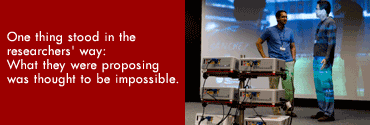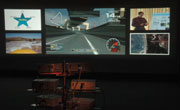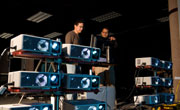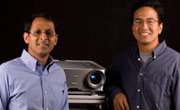|
|
 |
» |
|
|  |

By Simon Firth, June 2007
Super-bright, large-scale, and very high-resolution digital projectors are becoming indispensable tools of modern communication.
They help CEOs wow audiences of analysts. They make rock concerts intimate. They turn computer gaming into a spectator sport. And they can make digital cinema an instant reality almost anywhere in the world.
They are also very expensive. Prices for high-end projectors run into tens or even hundreds of thousands of dollars, which keeps these devices from being widely used.
|
|
HP Labs' Nelson Chang and Niranjan Damera-Venkata had a hunch they could make a much cheaper projection system by combining the outputs of several smaller projectors to create a single, high-quality image.
As the researchers saw it, only one thing stood in their way: What they were proposing was widely thought to be impossible.
Earlier work seemed to show that you could combine two images to create one higher-definition image only when the images were offset a very small and precise distance from each other. But projectors simply can't reliably throw images onto a screen that precisely - so no one had done it.
What if, the researchers wondered, you could find a way around this and combine two, or indeed 10, very imperfectly aligned projections to create a single, super-bright and super-resolution image?
"People were saying that mathematically you couldn't do it," recalls Damera-Venkata, but we found some loopholes no one had seen."
The result: a flexible projector technology called Pluribus that allows HP's customers to project crystal-clear, wall-sized images for a fraction the price of current projection systems.
|
How'd they do it? First, says researcher Chang, the system uses a camera to capture the image that each single projector throws onto a screen.
"With the camera in the loop," Chang says, "we can use a very precise and automated calibration process that figures out exactly how the projectors are misaligned and accounts for differences among them."
|
|

|
Even identical projectors will project images that vary in size, color, luminance and contrast, notes Chang. But send them through the Pluribus system, and the outputs from up to 12 projectors can be calibrated - with the best portions of each recombined to create a single picture of startling brightness and resolution.
[A paper on this work, Realizing Super-Resolution with Superimposed Projection, was selected as best paper at the 2007 IEEE International Workshop on Projector-Camera Systems (ProCams 2007).]
The technology builds on HP's wobulation technology. Researchers had observed they could improve a printed page's resolution without having to create smaller and smaller ink dots. Instead, they found that subtly altering the placement of the existing dots produced a dramatic difference in quality.
That insight enabled a similar improvement to the resolution of digital displays -- where alternating sets of pixels are offset from each other by a tiny, but regular degree, making it possible to project digital images at double their resolution for improved clarity without increased cost.
But applying wobulation to a multi-projector system was a little more complicated. "Unlike wobulation, where we can control environment, you have projectors that you essentially place arbitrarily," says Chang. "By using the camera, we can account for differences among different projectors, and adjust what they display accordingly."
|
Seeing Pluribus in action, it's easy to be overwhelmed by the huge, crystal-clear picture it creates. Hook a 16-foot screen up to a game of Madden NFL Football, for example, and the players are life-size - putting you front row and center at the same scale as the real thing.
Although Pluribus looks great, its true appeal lies in the cost savings it offers anyone in the business of projecting large images. How so? For example, Pluribus can combine ten off-the-shelf projectors costing $1,000 each to project an image as bright and sharp as that created by a single high-grade projector costing $100,000.
|
|

|
At the same time, Pluribus offers advantages over other multi-projector systems in image quality and labor savings. In conventional systems, it is not uncommon for two trained technicians to spend about six hours calibrating just two projectors, says Chang. In contrast, Pluribus' automated calibration process makes it possible for a single engineer to complete the task for all projectors in the system in about 10 minutes.
But Pluribus has other attractive features, notes Damera-Venkata.
"Say you are a big movie theater and you have a $100,000 projector," he suggests, "what happens if the projector fails? You are left without a show. Here you have redundancy, so that when one light goes off you still have nine projectors running. It's going to be little dimmer, but the show goes on."
Pluribus is also device neutral - it works with any number of projectors of any kind, which makes it easier for businesses to update and upgrade. In addition, it works on anything from a desktop to a stadium scale. It hits a sweet spot, though, at a distance where you want a very large picture, but where your viewers are still close enough to the screen to appreciate the image's very high definition.
|
Pluribus also offers flexibility in how it combines images to create a single screen.
The system allows multiple projected images to be superimposed upon each other to create a single image of unique brightness and resolution, for example. But it is also designed to work in a 'tile' pattern, which is how multiple projectors have typically have been used together.
|
|

|
Users don't have to choose between the tile or overlay patterns, but can adopt whatever display configuration best fits particular need. This allows a display designer to trade off screen ratio with brightness, resolution, redundancy, and cost, for example.
From the system's perspective, says Chang, "we don't really care about the exact projector configuration; Pluribus can optimize the final displayed image regardless. Basically what you have instead is a flexible canvas onto which you can just render things. And it all works in real time, so what you render can be anything from a single image to multiple videos at once."
He and Damera-Venkata are now working with others at HP to explore business opportunities.
With their generic system in place, they are fine-tuning Pluribus to work optimally in particular situations and for particular kinds of potential customers. Users who need to break a system down and repeatedly move it have different system requirements from users who always work in the same space, for example.
"Digital media is very important to HP," notes Chang. "And so it's important that we have competencies across the whole media pipeline - from its capture, through its manipulation, to displaying and sharing it."
"Pluribus," he says, "gives us a new and dynamic way to address the display end of the spectrum."
|
 |
|
